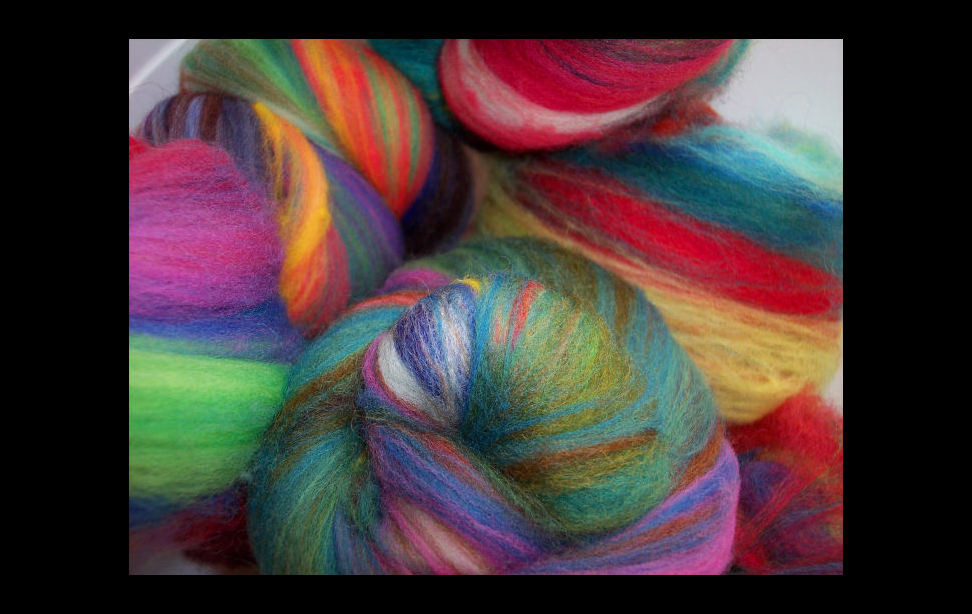Spinning Yarns: Threeravens' Christiane Knight
BALTIMORE, MARYLAND – Moved by the experience of knitting, Threeravens Fiber Studio founder Christiane Knight (as seen in photo 1) follows her rebellious streak and bends the traditions of the craft to match her aesthetic visions. After a career DJing for radio stations and nightclubs, Christiane Knight (often known as Xiane) took her knitting hobby to start a new line of work with a new line of her own art yarns at Threeravens, where her inspiration manifests itself in wild colors (as seen in photo 2) and unorthodox fabrics (as seen in photos 3 - 4).
thalo: So you went from being a DJ and dealing with underground and alternative music to also throwing yourself into making and selling yarn. How did yarn happen when you had such a commitment to music and nightlife?
Christiane Knight: It was a strange conjunction of events combined with the need to keep doing new things, actually. I picked up knitting while I was DJing in Baltimore and my co-DJ and I would work on projects during the slow early hours of the night. It finally dawned on me that I was pretty burned out on DJing, and really enjoying the yarn part of the knitting more than the knitting part of the knitting. Somehow this translated to “quit spinning music and start spinning wool” in my head (as seen in photos 5 - 6).
th: Your fiber studio, Threeravens uses the slogan, “Yarn and Fiber for Rebels.” Just what kind of rebellion are you hoping to agitate with your brightly colored and soft material?
CK: A mass uprising against being stuck in Traditional Ways—not that there’s anything wrong with tradition, but why stick to the path when all the really interesting things are over in that field?
My craft is a very old one. With that comes some resistance to embracing new techniques, ideas, textures, and uses. One of my biggest thrills is spinning up a super-textured yarn, having someone say “but what do I do with it?” Then when I start to rattle off ideas to use it, watching eyes light up with inspiration. That is why I like subverting the yarn paradigm...I love the idea that I can take something so simple, such an old idea as twisting fiber into thread, and really spark someone’s imagination.
th: What differentiates your “art yarns” from the standard mass-produced stuff?
CK: Art yarns or expressive yarns are yarns that are built from the traditional ideas and techniques that have been used for thousands of years to create yarn or thread for textiles, but [prepare for bad pun] with a twist. By taking the basic idea of “fiber + twist = yarn” and layering it, bunching it up, building textural interest or combining colors and fibers that aren’t generally used in conjunction, fiber artists take the idea of yarn as a workhorse and turn it on its head. It’s really a punk rock act in the fiber world. Sometimes we spin up something together just to see if we can, because breaking “rules” is FUN. Some of the yarns we create aren’t easily incorporated into textiles, but they serve as works of art all on their own.
th: What crafts do you think Threeravens fiber is best used for? Is there anything you think it’s not particularly well suited for?
CK: I have folks who use my yarn and fiber in an amazing variety of crafts. I currently know of uses in crochet, knitting, weaving, wet felting, needle felting, paper making, art dolls, jewelry, housewares, and other arts. I would say that matching the yarn or fiber to the project is the best recommendation I can give—I wouldn’t use a highly textured art yarn in a traditional sweater, but it would look great added to a hat or scarf. I’ve seen some amazing work done with adding art yarns as edging on a project. Some of my yarns are wearable without doing anything at all to them. They make fantastic glam-style necklaces.
th: Concerning the aesthetics of yarn-based, self-made products, from an outside perspective many of the crafts and clothing made with yarn come across as particularly hippie—maybe it’s because of the styles of the late 1960s and early 1970s. Yarn isn’t associated with traditional rock ‘n’ roll pieces like skin-tight black pants or a leather jacket. How do you reconcile the difference between yarn’s best-purposed end results and your own sense of style?
CK: I think the popular idea, one that those amazing creations from the ’60s and ’70s really helped hammer home, is that knitted and crocheted items are dowdy, hippie style, or just a little too “homespun” for a rock ‘n’ roll lifestyle. Thank GOODNESS that there are real trailblazers out there these days who are designing and creating a more kick-ass kind of yarny aesthetic. Some names to check out would be Lexi Boeger aka Pluckyfluff, Vickie Howell, Debbie Stoller, Share Ross, and Lee Meredith. Knitty offers some really edgy patterns.
And to toot my own horn. I use a technique called “tailspinning”—where one catches the tail end of wool locks and lets the rest hang down (as seen in photo 7) to make a crushingly glamtastic boa scarf that T Rex would have drooled over. It’s all in the attitude!
th: What inspires you or draws you toward your creations? Since you offer mostly craft customers one of a kind items, do you find that you return to many of your previous styles with the aim of changing them
slightly, or are new ideas approached in a different way?
CK: Nature is filled with amazing textures and colors to draw inspiration from, and I also often get ideas just from things I see around me and encounter in day to day life.
I tend to not repeat myself too often when it comes to styles, but there are definite trends in my work. Right now, I’m deep into hot and bright colors, kinda like the ’80s came and slapped me around with a day glo lace glove. Hot pink seems to be a common thing—and it’s selling like mad, who would guess? I have one very signature colorway that I do called Box of Crayons (as seen in photo 8)—it’s every crayon color one can imagine, carded in strong chunks, so it works up like a rainbow in projects. Other than that, I try to approach my work with a fresh mind every time. I’m always looking for the next challenge for myself in what I’m going to try.
th: Why does working with yarn benefit from group interaction in a way that many other arts don’t? There isn’t a popular idea of the “tortured knitter” alone with her painful artistic visions, right?
CK: I think there’s a couple of reasons for it, really. For one. there’s a long standing tradition of fiber arts being communal, since it used to be the only way to make clothing, and it was easier to do it in a big group and pool resources—so it became social, too, a chance to gather and gossip and share company. The “stitch and bitch” seems to fill that niche pretty well these days. Fiber work often has long, tedious stretches of repeating the same stitches, and that definitely calls for distraction in the form of company.
And for me, as a spinner, my mind is usually in need of entertainment while spinning, as my hands know what they’re doing without me and have even managed to make yarn when I’ve fallen asleep at the wheel! For me, spending time with other fiber artists gives me a welcome distraction, a chance to swap techniques/ideas/styles/insight, and a huge boost in creativity. We often teach each other valuable things just by working through issues with our projects together. I’d say that some of my best ideas have come from spinning at Knit Night.
th: And there seems to be a well-connected group of independent Baltimore craftspeople: is there anything specific to your community that impacts you creatively?
CK: Baltimore is lucky to have some really active and creative groups and people in the area. Charm City Craft Mafia puts on some amazing craft shows that I’ve been lucky enough to participate in, and I’d say that they’re one of the biggest reasons that I’m doing as well as I am in Baltimore. They led me to the yarn shop Lovelyarns that now houses my fiber studio as well as serves as the exclusive outlet for my yarns locally. Without CCCM and Lovelyarns, I wouldn’t be where I am right now. They’re the best.
th: Has teaching changed your view of what you do at Threeravens?
CK: I started teaching early in 2009, and I love it. Seriously, it’s the best thing—sharing what I do and watching people catch on and get excited by the creation process is amazing. I have learned so much by teaching. I learned to not be so hard on myself, because I was able to step outside of my own learning processes to watch my students progression, and I recognized my own previous mistakes and breakthroughs. I caught things that I’d missed or forgotten between the first days of spinning to my current skill level, and I was able to take those insights and expand them into ideas for new techniques. And I learned a lot about what I wanted and didn’t want in the fiber I work from, and that really informed how I process the fiber I sell and spin from now. I don’t think I could have learned all these things so easily without being a teacher.
th: What advice would you offer to someone who’s interested in making his or her own fibers?
CK: First, I’d take a trip to a sheep and wool festival near you if possible, so you can experience all aspects of the fiber world. It’s a great place to meet other fiber artists, see some of the vendors’ work up close, get to observe a variety of fiber animals, and maybe try out equipment like wheels or carders before investing. Make sure to go through the fleece sale area, there’s so much to learn there and I guarantee that people will offer advice, because that’s how fiber people are—so happy to share insight.
There’s a huge amount of info available for free online, too. I actually taught myself how to do almost everything I do via YouTube videos and tutorials online. I have some resources linked at my website that I found helpful.
My biggest piece of advice is to start with basic techniques, then dive into things you think are too challenging. Don’t be afraid. The best spinners and carders I know are always kids, because they’re completely unafraid to make mistakes or try crazy things. Everything is a learning opportunity, and you never know when you’ll suddenly develop a brand new technique and become a famous fiber artist!
All photos courtesy of Christiane Knight.















